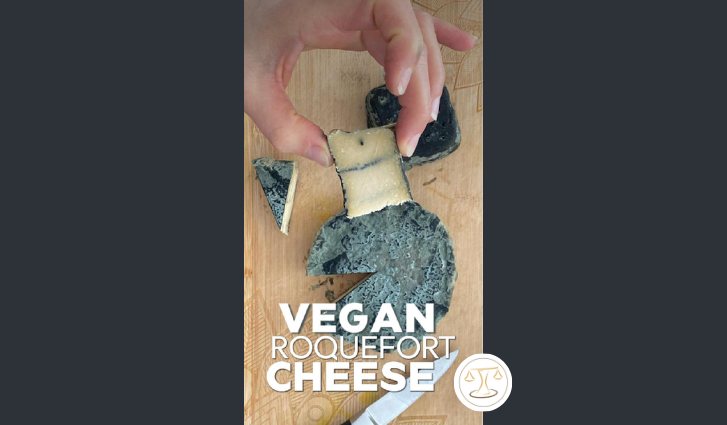Chef’s notes
This cashew blue cheese is a true plant-based delight, delivering the rich, tangy flavours you’d expect from traditional blue cheeses like Roquefort or Gorgonzola. The fermentation process, with the help of «Penicillium Roqueforti», creates a beautifully marbled, creamy cheese that’s both bold and complex. It’s a labor of love that rewards your patience with an unforgettable vegan cheese experience! Whether enjoyed on crackers, in salads, or simply on its own, this cheese will elevate any dish with its unique flavour profile.
Note 1: For this recipe you need parchment paper, a potent blender, glass jars with lid and two cheesecloths.
Note 2: Always use very clean tools, and avoid touching with your fingers or tasting with them while working on the cheese!
Details
- ⏲️ Prep time: 4-5 weeks
- 🍳 Cook time: 0
- 🍽️ Servings: Two small cheese loaves (2x 10-12 cm diameter)
Ingredients
- 300g raw cashews
- 3 tbsp water
- 3 tbsp kefir, kombucha or rejuvelac
- 2 tbsp coconut oil (raw, unrefined)
- 1-4 capsules vegan probiotics
- 1⁄2 tsp Himalayan salt (iodine-free, no additives)
- 1⁄16 tsp «Penicillium Roqueforti» (blue cheese mold culture)
Directions
- Day 1: Soak 300g of cashews overnight in water.
- Day 2: Rinse the soaked cashews thoroughly and let them drain well.
- In a high-speed blender, combine the cashews, 3 tbsp of water, 3 tbsp kefir or rejuvelac, and 2 tbsp coconut oil. Blend until the mixture is smooth and creamy.
- Add 1-4 capsules of vegan probiotics, 1⁄2 tsp Himalayan salt (free of iodine and additives), and blend again briefly.
- Add a pinch (about 1⁄16 tsp) of «Penicillium Roqueforti» powder (blue cheese culture) and give it another quick mix.
- Transfer the cashew mixture to a glass container, leaving the lid lightly on top (do not seal it completely) and store in a warm place, ideally in your kitchen, for 24 hours to ferment.
- Day 3: Divide the fermented cashew mixture into two smaller glass containers lined with cheesecloth. Press the mixture down firmly to eliminate air pockets.
- Store in a cool place (12-14°C / 53-57°F), ideally in a wine fridge.
- Day 4: Remove the cheese from the containers, take off the cheesecloth, and turn the cheese onto parchment paper.
- Sprinkle salt all over the cheese, ensuring it is evenly coated.
- Cover the cheese with larger glass bowls, ensuring that air can flow from underneath, and return to the wine fridge or the cool storage area.
- Days 4-7: Turn the cheese daily onto fresh parchment paper to maintain its texture.
- Day 7 or 8: Pierce the cheese with a thicker wooden skewer to create holes, allowing oxygen to reach the center, encouraging the blue mold to grow throughout the cheese, not just on the surface.
- Alternatively, crumble the cheese completely and then press it back into shape to ensure oxygen distribution.
- Days 8 toaround 12 or 15: Once the blue mold has fully developed around and inside the cheese, wrap the cheese in parchment paper, place it in a wooden cheese box, and then wrap it in a cloth bag.
- Transfer to a regular fridge to age for another 2-3 weeks or even several months, depending on your desired strength of flavour.

